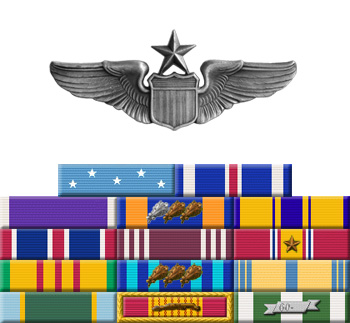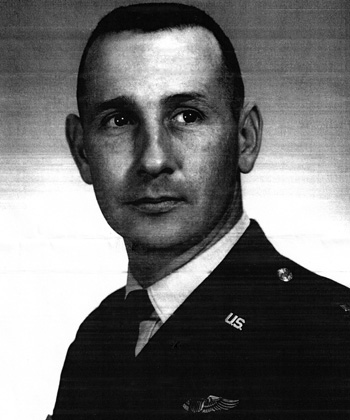Hilliard Wilbanks was born on July 26, 1933, in Cornelia, Georgia. He enlisted in the U.S. Air Force on August 8, 1950, and was trained as an Air Policeman at Tyndall AFB, Florida. After training, Wilbanks was assigned to the 43rd Air Police Squadron (later the 803rd Air Police Squadron) at Davis-Monthan AFB, Arizona, where he served from March 1951 to March 1954. He was then accepted into the Aviation Cadet Program, attending pilot training at Hondo and Laredo AFB, Texas. Wilbanks was commissioned a 2Lt in the Air Force and awarded his pilot wings on June 15, 1955. After additional training at Laredo AFB, he served as an instructor pilot with the 3506th Pilot Training Squadron at Greenville AFB, Mississippi, from September 1955 to January 1959. He then attended the Aircraft Maintenance Officer Course at Chanute AFB, Illinois, from January to November 1959, before being assigned to the 5010th Field Maintenance Squadron at Eielson AFB, Alaska. Wilbanks served at Eielson until June 1962, when he became a Flight Test Maintenance Officer with the 4520th Maintenance Group at Nellis AFB, Nevada. In March 1966, Capt Wilbanks completed aircraft upgrade training in the O-1 Bird Dog at Hurlburt Field, Florida. He was assigned as a forward air controller with the 505th Tactical Control Group at Tan Son Nhut AB in the Republic of Vietnam in April 1966, and then with the 21st Tactical Air Support Squadron at Plei Ku Airport and then Nha Trang AB, both in South Vietnam. On February 24, 1967, while flying his 488th combat mission in Southeast Asia, Capt Wilbanks was killed in action during a mission in which he would later be posthumously awarded the Medal of Honor. He is buried at the Fayette City Cemetery in Fayette, Mississippi. Hilliard Wilbanks was inducted into the Georgia Aviation Hall of Fame in April 2001.
His Medal of Honor Citation reads:
For conspicuous gallantry and intrepidity in action at the risk of his life above and beyond the call of duty. As a forward air controller Capt. Wilbanks was pilot of an unarmed, light aircraft flying visual reconnaissance ahead of a South Vietnam Army Ranger Battalion. His intensive search revealed a well-concealed and numerically superior hostile force poised to ambush the advancing rangers. The Viet Cong, realizing that Capt. Wilbanks' discovery had compromised their position and ability to launch a surprise attack, immediately fired on the small aircraft with all available firepower. The enemy then began advancing against the exposed forward elements of the ranger force which were pinned down by devastating fire. Capt. Wilbanks recognized that close support aircraft could not arrive in time to enable the rangers to withstand the advancing enemy, onslaught. With full knowledge of the limitations of his unarmed, unarmored, light reconnaissance aircraft, and the great danger imposed by the enemy's vast firepower, he unhesitatingly assumed a covering, close support role. Flying through a hail of withering fire at treetop level, Capt. Wilbanks passed directly over the advancing enemy and inflicted many casualties by firing his rifle out of the side window of his aircraft. Despite increasingly intense antiaircraft fire, Capt. Wilbanks continued to completely disregard his own safety and made repeated low passes over the enemy to divert their fire away from the rangers. His daring tactics successfully interrupted the enemy advance, allowing the rangers to withdraw to safety from their perilous position. During his final courageous attack to protect the withdrawing forces, Capt. Wilbanks was mortally wounded and his bullet-riddled aircraft crashed between the opposing forces. Capt. Wilbanks' magnificent action saved numerous friendly personnel from certain injury or death. His unparalleled concern for his fellow man and his extraordinary heroism were in the highest traditions of the military service, and have reflected great credit upon himself and the U.S. Air Force.
|



